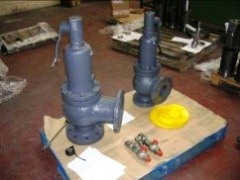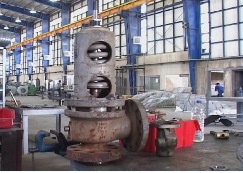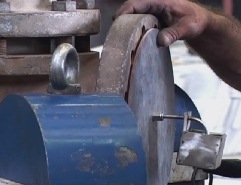Pressure Safety Valve Inspection
The Pressure Safety Valve Inspection article provides you information about inspection of pressure safety valve and pressure safety valve test in manufacturing shop as well as in operational plants.
What is Pressure Safety Valve Definition?

The pressure safety valve inspection is included in the I4I Academy API 510 pressure vessel inspector course. The topic is discussed in API RP 576 - Inspection of Pressure-Relieving Devices, and this recommended practice is part of the API 510 training program. The same things also are covered in API 570 piping inspector course.
Your pressure safety valve is a direct spring-loaded pressure-relief valve that is opened by the static pressure upstream of the valve and characterized by rapid opening or pop action.
When the static inlet pressure reaches the set pressure, it will increase the pressure upstream of the disk and overcome the spring force on the disk.
Fluid will then enter the huddling chamber, providing additional opening force.
This will cause the disk to lift and provide full opening at minimal overpressure.
The closing pressure will be less than the set pressure and will be reached after the blowdown phase is completed.
What is Pressure Safety Valve Inspection in Manufacturing Shop?

Your construction code for pressure safety valve is API Standard 526 and covers the minimum requirements for design, materials, fabrication, inspection, testing, and commissioning.
If you need directly go to detail of the inspection process review Inspection and Test Plan for Pressure Safety Valve draft sheet.
You need to use the other API Recommendation practices in conjunction of API STD 526 for design and construction purpose.
These are:
- API Recommended Practice 520 for Sizing and Selection
- API Recommended practice 521 Guideline for Pressure Relieving and Depressing Systems
- API Recommended Practice 527 Seat Tightness of Pressure Relief Valves
Between above supporting recommend practices only API RP 527 specifically refers to the inspection and test for pressure safety valve construction.
Pressure safety valve manufacture certification sometimes is mandatory by regulation of local authority.
For example in the state of Minnesota the ASME Code application and stamping for pressure vessel and boiler is mandatory which “U” and “S” symbols are designated for stamping on the nameplate.
For more detail on the certification process review Pressure Vessel Certification article.
The “UV” symbol was designated for pressure safety valves by ASME.
For example if there is pressure vessel need to be installed in the state of Minnesota then the pressure vessel nameplate shall be U stamped and pressure vessel safety valve shall be UV stamped.
So pressure safety valve manufactures which wanted to stamp UV symbol in their products shall apply for stamp holding certification from ASME.
National Board Inspection Code (NBIC) have own certification scheme for pressure safety valves and using NB symbol. The NBIC code book for this certification is NB 18.
National Board Inspection Code is assisting ASME organization for ASME UV symbol certification by providing ASME designee in manufactures auditing program.
There are some other standards and codes which are used in pressure safety valve such as:
- ASME PTC 25 for pressure relief devices which majorly is used for assessment of testing facility and apparatus for safety valves
- BS EN ISO 4126-1, 4126-2 and 4126-3 which is construction standard similar to API STD 526.
Following link provide you the step by step activities required for pressure safety valve inspection in manufacturing process.
Review Inspection and Test Plan for Pressure Safety Valve Draft.
What is In-Service Inspection Requirement for Pressure Safety Valve?

The In-Service Inspection code for your pressure safety valve inspection is API Recommend Practice 576.
The title of the code is Inspection of Pressure-relieving Devices and covers all in-service inspection and testing requirement.
This API RP 527 might be used in conjunction of API RP 576 as testing procedure for seat tightness testing of pressure safety valve for periodical servicing and inspection.
What is Important Item in the Pressure Safety Valve Inspection?
These are only important points or summery of points for pressure safety valve in-service inspection and should not be assumed as pressure safety valve inspection procedure.
Pressure safety valve inspection procedure is comprehensive document which need to cover inspection methods to be employed, equipment and material to be used, qualification of inspection personnel involved and the sequence of the inspection activities as minimum.
You may use following content as summery of points for Pressure Safety Valve Inspection in operational plant
- Determination pressure safety valve inspection interval based API STD 510 and API RP 576 requirements
- Inspection of inlet and outlet piping after pressure safety valve removal for any fouling
- Inspection of pressure safety valve charge and discharge nozzles for possible deposit and corrosion products
- Taking care for proper handling of pressure safety valves from unit to the valve shop. The detail of handling and transportation instruction is provided in API RP 576.
- Controlling of seals for being intact when the valves arrived to the valve shop.
- Making as received POP test and recording the relieving pressure.
- If the POP pressure is higher than the set pressure the test need to be repeated and if in the second effort it was near to the set pressure it is because of deposit.
- If in the second effort it was not opened near to the set pressure either it was set wrongly or it was changed during the operation
- If the pressure safety valve was not opened in 150% of set pressure it should be considered as stuck shut.
- If the pressure safety valve was opened below the set pressure the spring is weakened
- Making external visual inspection on pressure safety valve after POP test. The test need contain following item as minimum;
- the flanges for pitting and roughness
- The spring and bellows for corrosion and cracking
- The external surface for any corrosion and mechanical damage
- Making body wall thickness measurement
- Dismantling of pressure safety valve if the result of as received POP test was not satisfactory
- Making detail and comprehensive visual and dimensional inspection on the dismantled valve parts (after cleaning)
- Making special attention to the dismantled valves seating surfaces inspection e.g. disk and seat for roughness, wear and damage which might cause valve leakage in service
- Replacing the damaged parts in dismantled valves based manufacture recommendation and API RP 576 requirements
- Making precise setting of the pressure safety valve after reassembly based manufacture recommendation or NB-18 requirements

- Making at least two POP test after setting and making sure the deviation from set pressure is not more than 2 psi for valves with set pressure equal or less than 70 psi or 3% for valves with set pressure higher than 70 psi
- Making valve tightness test for leakage purpose after approval of the setting pressure and POP tests. The test method and acceptance criteria must be according to the API RP 576. The API RP 527 also can be used for pressure safety valve tightness test.
- Recording and maintaining the inspection and testing results.
2 Free CPD Hours Courses - Completely Free
Enroll, Watch the Video, Take the Test, Download Your Cert and Submit to the API . 2 free courses are availble each with 2 hours credit. (Total 4 hours) - 1) ASME V Articl II , 2) ASME V Article 6 & 7